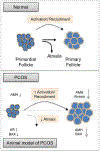Ovarian and Extra-Ovarian Mediators in the Development of Polycystic Ovary Syndrome
- PMID: 29941488
- PMCID: PMC6192837
- DOI: 10.1530/JME-18-0079
Ovarian and Extra-Ovarian Mediators in the Development of Polycystic Ovary Syndrome
Abstract
Polycystic ovary syndrome (PCOS) is a heterogeneous endocrine disorder affecting women of reproductive age. The origin of PCOS is still not clear and appears to be a function of gene x environment interactions. This review addresses the current knowledge of the genetic and developmental contributions to the etiology of PCOS, the ovarian and extra-ovarian mediators of PCOS and the gaps and key challenges that need to be addressed in the diagnosis, treatment and prevention of PCOS.
Figures




Similar articles
-
Interlukin-22 improves ovarian function in polycystic ovary syndrome independent of metabolic regulation: a mouse-based experimental study.J Ovarian Res. 2024 May 11;17(1):100. doi: 10.1186/s13048-024-01428-x. J Ovarian Res. 2024. PMID: 38734641 Free PMC article.
-
Selective ovary resistance to insulin signaling in women with polycystic ovary syndrome.Fertil Steril. 2003 Oct;80(4):954-65. doi: 10.1016/s0015-0282(03)01007-0. Fertil Steril. 2003. PMID: 14556818
-
Humanin regulates oxidative stress in the ovaries of polycystic ovary syndrome patients via the Keap1/Nrf2 pathway.Mol Hum Reprod. 2021 Feb 5;27(2):gaaa081. doi: 10.1093/molehr/gaaa081. Mol Hum Reprod. 2021. PMID: 33337472
-
[Anti-Mullerian hormone- its role in the pathogenesis of the polycystic ovary syndrome].Akush Ginekol (Sofiia). 2012;51(6):22-6. Akush Ginekol (Sofiia). 2012. PMID: 23390860 Review. Bulgarian.
-
Endocrine Disrupting Chemicals in Polycystic Ovary Syndrome: The Relevant Role of the Theca and Granulosa Cells in the Pathogenesis of the Ovarian Dysfunction.Cells. 2022 Dec 31;12(1):174. doi: 10.3390/cells12010174. Cells. 2022. PMID: 36611967 Free PMC article. Review.
Cited by
-
Polycystic Ovary Syndrome: Pathophysiology, Presentation, and Treatment With Emphasis on Adolescent Girls.J Endocr Soc. 2019 Jun 14;3(8):1545-1573. doi: 10.1210/js.2019-00078. eCollection 2019 Aug 1. J Endocr Soc. 2019. PMID: 31384717 Free PMC article. Review.
-
Exploring the innovative application of cerium oxide nanoparticles for addressing oxidative stress in ovarian tissue regeneration.J Ovarian Res. 2024 Dec 5;17(1):241. doi: 10.1186/s13048-024-01566-2. J Ovarian Res. 2024. PMID: 39633503 Free PMC article. Review.
-
Glycoprotein G-protein Coupled Receptors in Disease: Luteinizing Hormone Receptors and Follicle Stimulating Hormone Receptors.Diseases. 2020 Sep 15;8(3):35. doi: 10.3390/diseases8030035. Diseases. 2020. PMID: 32942611 Free PMC article. Review.
-
Developmental Programming: Prenatal Testosterone Excess on Ovarian SF1/DAX1/FOXO3.Reprod Sci. 2020 Jan;27(1):342-354. doi: 10.1007/s43032-019-00029-0. Epub 2020 Jan 1. Reprod Sci. 2020. PMID: 32046386 Free PMC article.
-
Application of Pulsed Rhythmic Drug Administration to Ovulation Induction Therapy in PCOS Patients with Clomiphene-Resistance: a Retrospective Research.Reprod Sci. 2021 Nov;28(11):3193-3199. doi: 10.1007/s43032-021-00639-7. Epub 2021 Jun 3. Reprod Sci. 2021. PMID: 34085207 Free PMC article.
References
-
- Abbott DH, Barnett DK, Bruns CM & Dumesic DA 2005. Androgen excess fetal programming of female reproduction: a developmental aetiology for polycystic ovary syndrome? Hum Reprod Update 11 357–374. - PubMed
-
- Abbott DH, Dumesic DA, Eisner JR, Colman RJ & Kemnitz JW 1998. Insights into the development of polycystic ovary syndrome (PCOS) from studies of prenatally androgenized female rhesus monkeys. Trends Endocrinol Metab 9 62–67. - PubMed
-
- Adashi EY, Hsueh AJ & Yen SS 1981. Insulin enhancement of luteinizing hormone and follicle-stimulating hormone release by cultured pituitary cells. Endocrinology 108 1441–1449. - PubMed
-
- Albertini DF 2015. Chapter 2 - The Mammalian Oocyte. In Knobil and Neill’s Physiology of Reproduction (Fourth Edition), pp 59–97. San Diego: Academic Press.
Publication types
MeSH terms
Substances
Grants and funding
LinkOut - more resources
Full Text Sources
Other Literature Sources
Medical

